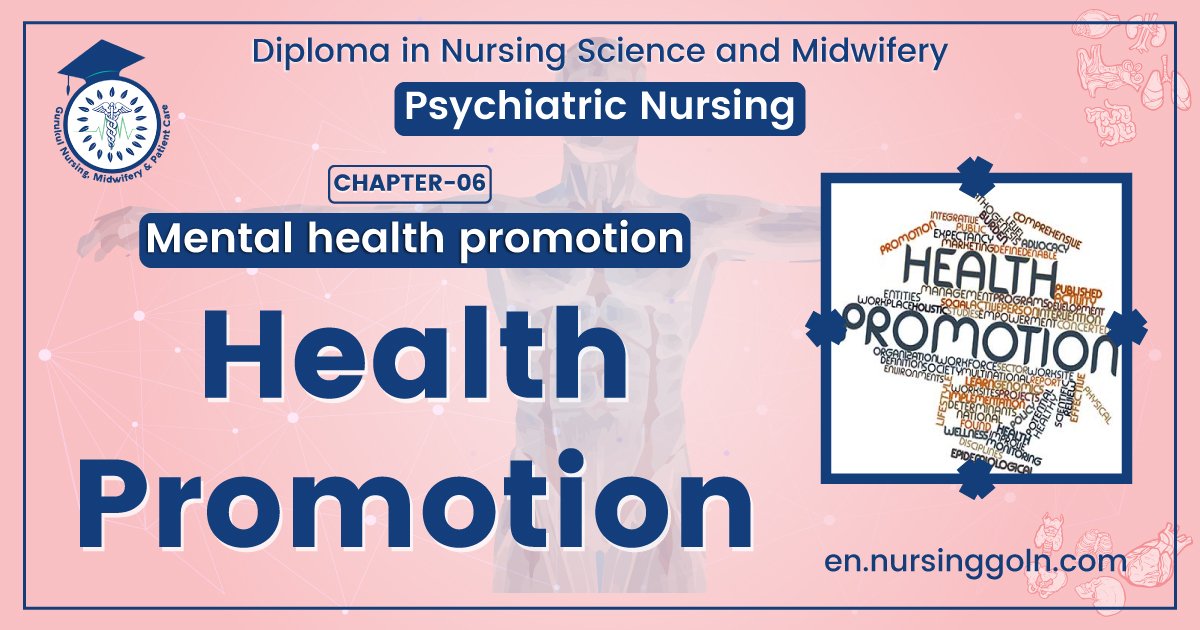Definition of Health promotion – This book covers the entire syllabus of “Psychiatric Nursing” prescribed by the Universities of Bangladesh- for Basic and diploma nursing students. We tried to accommodate the latest information and topics. This book is an examination-friendly setup according to the teachers’ lectures and examination questions.
At the end of the book previous university questions are given. We hope in touch with the book students’ knowledge will be upgraded and flourish. The unique way of presentation may make your reading of the book a pleasurable experience.

Definition of Health promotion
Approaches/Intervention of mental health promotion:
The well-known approaches/intervention of health promotion are –
1. Health education
2. Environmental modification
3. Nutritional intervention
4. Life style and behavioral changes.
Approaches/Intervention of mental health promotion:
1. Health education:Tills is one of the most cost-effective interventions. A large number of diseases could be prevented with little or no medical intervention if people were adequately informed about them and if people were encouraged to take necessary precaution in time. The targets for educational efforts may include the general public, patients, priority groups, health Providers’ community leaders, & decision makers.
2. Environmental modification: Health promotion requires environmental modifications such as-
➤ Provision of safe water,
➤ Installation of sanitary latrines
➤ Improvement of housing etc.
➤ Control of insects and rodents;
Environmental intervention are non-clinical and do not involve the physician.
3. Nutrition Interventions: These comprise food distribution and nutrition improvement of vulnerable groups; child feeding programs food fortification, and nutrition education etc.
4. Lifestyle and Behavioral changes: The conventional public health measures or interventions have not been successful in making inroads into lifestyle reform. The action of prevention in this case, is one of individual and community responsibility for health. The physician and intact each health worker acting as an educator than a therapist.
5. Disease prevention and Control: Disease prevention means not only preventing the development of a disease but also in a broad sense, limiting the progression of disease at any stage. It is also important to help the clients identify risks for illness or injury so that they can make important decision to maintain or improve their health status by taking risk reduction action.
The basic approach in controlling disease is to identify the weak points and break the weakest links in the chain of transmissions. This requires sound epidemiological knowledge of the disease that is its magnitude, distribution in time, place, person, and multifactorial causation, sources of infection and dynamics of transmission.
[Ref- Lesson Plan Volume 2/p 23, 2 24, 25]
Prevention of mental illness
Prevention of mental illness:
The prevention of mental illness is based on public health principles and has been divided into:
1. Primary prevention.
2. Secondary prevention.
3. Tertiary prevention.
The aim of prevention is to decrease, the onset (incidence), duration (prevalence) and residual disability of mental disorder.

A. Primary Prevention: Primary prevention involves the promotion of general mental health and protection against the occurrence of specific diseases. Primary prevention aims to prevent the onset of a disease or disorder, thereby reducing the incidence (number of new cases occurring in a specific period of time).
Measures for primary prevention include:
1. Elimination of etiological agents.
2. Reducing risk factors.
3. Enhancing host resistance or interfering with disease transmission.
4. Reducing stress factors
5. Counseling
➤ Student’s counseling
➤ Marriage counseling
➤ Sex counseling
➤ Genetic counseling.
6. Special centers
➤ Child guidance center
➤ Crisis intervention center
➤ Geriatric center

7. Mental health education
➤ The message of prevention, early recognition and effective treatment should reach them.
➤ Repeated efforts to give correct information will lead to a positive change and the misconceptions about mental illnesses removed.
B. Secondary Prevention: Early identification and effective treatment of an illness or disorder with the goal of reducing the prevalence (total number of existing cases in a year) is the aim of secondary prevention. The essential components of secondary prevention are –
➤ Population screening
➤ Crisis intervention services
➤ Mental health promotion
C. Tertiary prevention: This aims to reduce the prevalence of residual defect or disability due to illness or disorder. Tertiary prevention involves rehabilitation after defect and disability have been fixed. Human behavior can be changed, by gradual shaping, into completely new responses.
This can be achieved by behavior therapy methods like token economy. Modem tertiary prevention of mental illness or rehabilitation of the seriously disabled mentally ill persons is one of the great success stories of psychiatry.
[Ref: S Nambl/2/173-174]
Read more:
